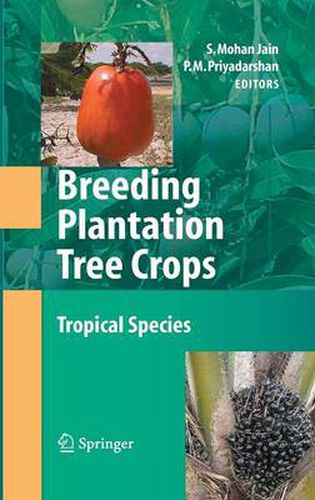Readings Newsletter
Become a Readings Member to make your shopping experience even easier.
Sign in or sign up for free!
You’re not far away from qualifying for FREE standard shipping within Australia
You’ve qualified for FREE standard shipping within Australia
The cart is loading…






This title is printed to order. This book may have been self-published. If so, we cannot guarantee the quality of the content. In the main most books will have gone through the editing process however some may not. We therefore suggest that you be aware of this before ordering this book. If in doubt check either the author or publisher’s details as we are unable to accept any returns unless they are faulty. Please contact us if you have any questions.
Tree species are indispensable to support human life. Due to their long life cycle and environmental sensitivity, breeding trees to suit day-to-day human needs is a formidable challenge. Whether they are edible or industrial crops, improving yield under optimal, sub-optimal and marginal areas calls for uni?ed efforts from the s- entistsaroundtheworld. Whiletheuniquenessofcoconutaskalpavriksha(Sanskr- meaning tree-of-life) marks its presence in every continent from Far East to South America, tree crops like cocoa, oil palm, rubber, apple, peach, grapes and walnut prove their environmental sensitivity towards tropical, sub-tropical and temperate climates. Desert climate is quintessential for date palm. Thus, from soft drinks to breweries to beverages to oil to tyres, the value addition offers a spectrum of pr- ucts to human kind, enriched with nutritional, environmental, ?nancial, social and trade related attributes. Taxonomically, tree crops do not con?ne to a few families, but spread across a section of genera, an attribute so unique that contributes immensely to genetic biodiversity even while cultivated at the commercial scale. Many of these species in?uence other ?ora to nurture in their vicinity, thus ensuring their integrity in p- serving the genetic biodiversity. While wheat, rice, maize, barley, soybean, cassava andbananamakeup themajorfoodstaples,manyfruittreespeciescontributegreatly tonutritionalenrichment inhumandiet. Theediblepartofthesespeciesisthesource of several nutrients that makes additives for the daily diet of humans, for example, vitamins, sugars, aromas and ?avour compounds, and raw material for food proce- ing industries. Tree crops face an array of agronomic and horticultural problems in propagation, yield, appearance, quality, diseases and pest control, abiotic stresses and poor shelf-life.
$9.00 standard shipping within Australia
FREE standard shipping within Australia for orders over $100.00
Express & International shipping calculated at checkout
This title is printed to order. This book may have been self-published. If so, we cannot guarantee the quality of the content. In the main most books will have gone through the editing process however some may not. We therefore suggest that you be aware of this before ordering this book. If in doubt check either the author or publisher’s details as we are unable to accept any returns unless they are faulty. Please contact us if you have any questions.
Tree species are indispensable to support human life. Due to their long life cycle and environmental sensitivity, breeding trees to suit day-to-day human needs is a formidable challenge. Whether they are edible or industrial crops, improving yield under optimal, sub-optimal and marginal areas calls for uni?ed efforts from the s- entistsaroundtheworld. Whiletheuniquenessofcoconutaskalpavriksha(Sanskr- meaning tree-of-life) marks its presence in every continent from Far East to South America, tree crops like cocoa, oil palm, rubber, apple, peach, grapes and walnut prove their environmental sensitivity towards tropical, sub-tropical and temperate climates. Desert climate is quintessential for date palm. Thus, from soft drinks to breweries to beverages to oil to tyres, the value addition offers a spectrum of pr- ucts to human kind, enriched with nutritional, environmental, ?nancial, social and trade related attributes. Taxonomically, tree crops do not con?ne to a few families, but spread across a section of genera, an attribute so unique that contributes immensely to genetic biodiversity even while cultivated at the commercial scale. Many of these species in?uence other ?ora to nurture in their vicinity, thus ensuring their integrity in p- serving the genetic biodiversity. While wheat, rice, maize, barley, soybean, cassava andbananamakeup themajorfoodstaples,manyfruittreespeciescontributegreatly tonutritionalenrichment inhumandiet. Theediblepartofthesespeciesisthesource of several nutrients that makes additives for the daily diet of humans, for example, vitamins, sugars, aromas and ?avour compounds, and raw material for food proce- ing industries. Tree crops face an array of agronomic and horticultural problems in propagation, yield, appearance, quality, diseases and pest control, abiotic stresses and poor shelf-life.